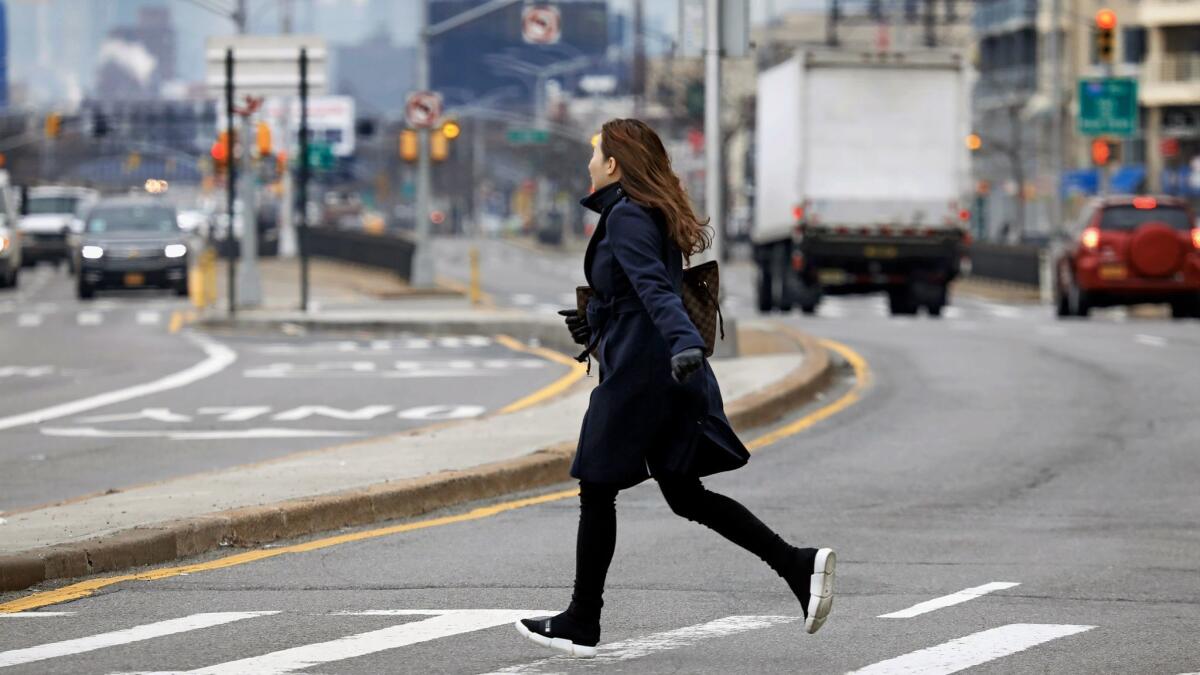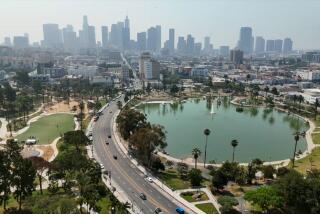‘Vision Zero’ brings traffic fatalities in New York to an all-time low
- Share via
Reporting from New York — It was once known as the “Boulevard of Death.”
Between 1990 and 2015, a total of 185 people — most of them pedestrians — were killed in traffic accidents along its 12 lanes and its vast intersections.
Today Queens Boulevard is as busy as ever, a moving puzzle of buses, baby strollers, delivery trucks, ambulances, bicycles and pedestrians, including Marco Portillo, who was scurrying toward a bus stop on a recent afternoon hand-in-hand with his wife and three children.
“We never let go of them,” he said.
But in the last three years, not a single pedestrian or cyclist has been killed along the seven-mile main drag through New York’s largest borough. It has become exhibit A in “Vision Zero,” Mayor Bill de Blasio’s initiative to eliminate traffic fatalities in the city within 10 years.
Started in 2014 at the beginning of the mayor’s first term to fulfill a campaign promise, the $1.6-billion effort aims to use legislation, enforcement, education and engineering to change behavior and make streets safer.

It appears to be working. Total traffic fatalities in the city, including those involving pedestrians, cyclists, motorcyclists and motor vehicles, fell from 299 in 2013 to an all-time low of 214 last year.
Pedestrian deaths were down from 184 to 101, though deaths of bicyclists rose from 12 to 23.
“The last time New York City streets were this safe, people were getting around with a horse and buggy,” De Blasio said at a news conference in January.
City Councilman Jimmy Van Bramer of Queens touted the program as a model for other cities that have been struggling to integrate growing numbers of vehicles, bicycles and pedestrians on outdated roads.
“If you can make Queens Boulevard safer, you can make any street in this city and country safer,” he said at the news conference.
Boston, Chicago, San Diego and Seattle have also introduced similar programs in recent years, with mixed results. In Los Angeles, Mayor Eric Garcetti created his own Vision Zero, but in 2016, its first full year in effect, traffic deaths rose more than 40%.
The concept originated in Sweden in the 1990s. Its guiding philosophy is that no loss of life or serious injury on roadways is acceptable.
“Once you decide that safety is the priority … a lot flows from that,” said Paul Steely White, executive director of Transportation Alternatives, a local advocacy group that promotes public transit, bicycles and walking over driving.
Take street redesign, for example.
Since 2014, the New York City Department of Transportation has made hundreds of safety improvements to Queens Boulevard and other streets: removing parking spots and vehicle lanes to make room for protected bike lanes and pedestrian space; adding stop signs to “slip” lanes; and installing “leading intervals” at traffic lights that allow pedestrians to start crossing before cars are allowed to proceed.
Transportation officials have also worked with the city’s Police Department to step up enforcement of traffic laws. Last year, police issued nearly 550,000 summons for speeding, failing to yield to pedestrians or cyclists, making improper turns and disobeying traffic signs or signals — up from 340,000 in 2013, according to the department.
Perhaps the biggest change was the reduction in the citywide default speed limit from 30 mph to 25 mph in 2014. The new speed limit, which applies to nearly 90% of city streets and required state approval, helps drivers and pedestrians avoid collisions and makes it half as likely a pedestrian will be killed if one does occur, according to the city.
“When we lowered the speed limit, a lot of people said the sky would fall,” De Blasio said when announcing the latest statistics. “Well, it didn’t. Most New Yorkers recognize it was making people safer.”
Amy Cohen, a co-founder of the advocacy group Families for Safe Streets, campaigned for the lower speed limit, standing outside her Brooklyn home with a radar gun to measure car speeds after her 12-year-old son, Sammy Cohen Eckstein, was hit and killed by a van there in 2013.
“It is making a difference,” she said of the new limit.
About a year and a half after Sammy died, 5-year-old Roark Bennett was struck at the same intersection.
Roark lived — an outcome his mother attributed to the lower speed limit.
Transportation Commissioner Polly Trottenberg said the initiative has had support from all corners of the city, as well as state elected officials.
“That’s made a big difference in terms of our ability to do some very aggressive and important safety projects as well as to garner some very major resources,” she said.
It took years to overcome fierce opposition to narrowing roadways to create bike lanes and pedestrian plazas — efforts that began under the previous mayor, Michael R. Bloomberg.
Still, not everyone has backed the latest changes. Community Board 4 in Queens opposed the addition of bike lanes.
“The idea of shrinking down Queens Boulevard — while it was great for safety purposes, we just felt it would have created even more congestion,” said Christian Cassagnol, the board’s district manager. “And essentially that is what happened.”
Cassagnol said traffic around the Queens Center mall is mayhem, “like holiday season all the time.”
Linda O’Rourke, 70, who lives a block north of Queens Boulevard in the Elmhurst neighborhood and walks with a cane, avoids crossing the street because it feels unsafe. But she echoed the feelings of other locals when she complained about the new bike lanes.
“The bicycle lanes are a problem because they cut the traffic” space, she said, adding that the commute to Manhattan takes longer now.
Trottenberg said her agency tries to keep traffic flowing, but with New York’s population growing, tourism surging and construction booming, she has to balance competing needs.
“The commitment of Vision Zero as a philosophy is that crashes are preventable,” she said. “I don’t think that means that you have carte blanche to remove every car on the road. You nonetheless have to operate within a major city and an existing transportation system.”
Some advocates say the city needs to do more, and faster.
“You need to make these improvements the rule and not the exception on New York City streets,” said White of Transportation Alternatives. “If there was a wholesale adoption … we could be saving hundreds of lives, not just scores.”
Twitter: @AgrawalNina
More to Read
Sign up for Essential California
The most important California stories and recommendations in your inbox every morning.
You may occasionally receive promotional content from the Los Angeles Times.











